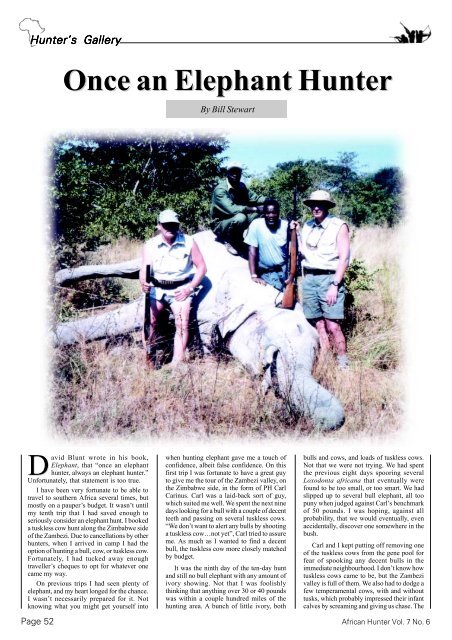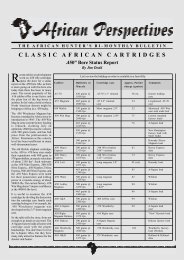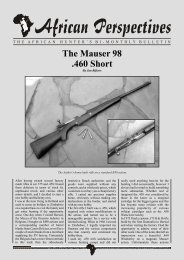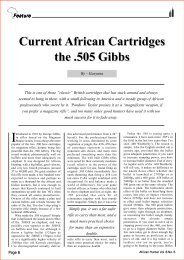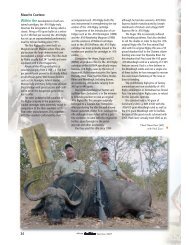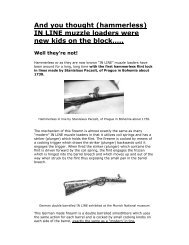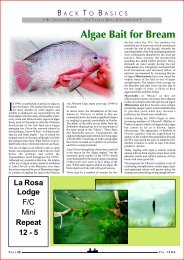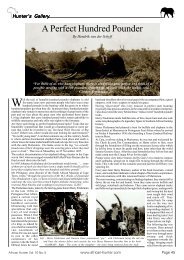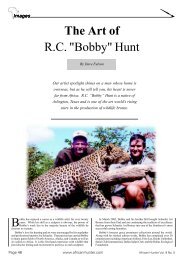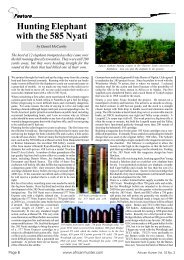Once an Elephant Hunter - HuntNetwork
Once an Elephant Hunter - HuntNetwork
Once an Elephant Hunter - HuntNetwork
Create successful ePaper yourself
Turn your PDF publications into a flip-book with our unique Google optimized e-Paper software.
<strong>Hunter</strong>'s <strong>Hunter</strong>'s <strong>Hunter</strong>'s Gallery Gallery<br />
Gallery<br />
<strong>Once</strong> <strong>an</strong> Eleph<strong>an</strong>t <strong>Hunter</strong><br />
David<br />
D<br />
Blunt wrote in his book,<br />
Eleph<strong>an</strong>t, that “once <strong>an</strong> eleph<strong>an</strong>t<br />
hunter, always <strong>an</strong> eleph<strong>an</strong>t hunter.”<br />
Unfortunately, that statement is too true.<br />
I have been very fortunate to be able to<br />
travel to southern Africa several times, but<br />
mostly on a pauper’s budget. It wasn’t until<br />
my tenth trip that I had saved enough to<br />
seriously consider <strong>an</strong> eleph<strong>an</strong>t hunt. I booked<br />
a tuskless cow hunt along the Zimbabwe side<br />
of the Zambezi. Due to c<strong>an</strong>cellations by other<br />
hunters, when I arrived in camp I had the<br />
option of hunting a bull, cow, or tuskless cow.<br />
Fortunately, I had tucked away enough<br />
traveller’s cheques to opt for whatever one<br />
came my way.<br />
On previous trips I had seen plenty of<br />
eleph<strong>an</strong>t, <strong>an</strong>d my heart longed for the ch<strong>an</strong>ce.<br />
I wasn’t necessarily prepared for it. Not<br />
knowing what you might get yourself into<br />
By Bill Stewart<br />
when hunting eleph<strong>an</strong>t gave me a touch of<br />
confidence, albeit false confidence. On this<br />
first trip I was fortunate to have a great guy<br />
to give me the tour of the Zambezi valley, on<br />
the Zimbabwe side, in the form of PH Carl<br />
Carinus. Carl was a laid-back sort of guy,<br />
which suited me well. We spent the next nine<br />
days looking for a bull with a couple of decent<br />
teeth <strong>an</strong>d passing on several tuskless cows.<br />
“We don’t w<strong>an</strong>t to alert <strong>an</strong>y bulls by shooting<br />
a tuskless cow…not yet”, Carl tried to assure<br />
me. As much as I w<strong>an</strong>ted to find a decent<br />
bull, the tuskless cow more closely matched<br />
by budget.<br />
It was the ninth day of the ten-day hunt<br />
<strong>an</strong>d still no bull eleph<strong>an</strong>t with <strong>an</strong>y amount of<br />
ivory showing. Not that I was foolishly<br />
thinking that <strong>an</strong>ything over 30 or 40 pounds<br />
was within a couple hundred miles of the<br />
hunting area. A bunch of little ivory, both<br />
bulls <strong>an</strong>d cows, <strong>an</strong>d loads of tuskless cows.<br />
Not that we were not trying. We had spent<br />
the previous eight days spooring several<br />
Loxodonta afric<strong>an</strong>a that eventually were<br />
found to be too small, or too smart. We had<br />
slipped up to several bull eleph<strong>an</strong>t, all too<br />
puny when judged against Carl’s benchmark<br />
of 50 pounds. I was hoping, against all<br />
probability, that we would eventually, even<br />
accidentally, discover one somewhere in the<br />
bush.<br />
Carl <strong>an</strong>d I kept putting off removing one<br />
of the tuskless cows from the gene pool for<br />
fear of spooking <strong>an</strong>y decent bulls in the<br />
immediate neighbourhood. I don’t know how<br />
tuskless cows came to be, but the Zambezi<br />
valley is full of them. We also had to dodge a<br />
few temperamental cows, with <strong>an</strong>d without<br />
tusks, which probably impressed their inf<strong>an</strong>t<br />
calves by screaming <strong>an</strong>d giving us chase. The<br />
Page 52 Afric<strong>an</strong> <strong>Hunter</strong> Vol. 7 No. 6
government scout probably expended more<br />
ammunition that week over the heads of irate<br />
cows th<strong>an</strong> on the practice r<strong>an</strong>ge in the last<br />
two or three years.<br />
We were spending the morning of the ninth<br />
day spooring a fairly big bull, if the tracks<br />
were <strong>an</strong>y indication, but the tracks were mixed<br />
up with the cows <strong>an</strong>d calves, <strong>an</strong>d progress<br />
was pretty slow. I was silently hoping it<br />
would be more successful th<strong>an</strong> the day before.<br />
We had tracked one big bull but eventually<br />
lost it. Too hot <strong>an</strong>d too tired by the late<br />
afternoon, we were trudging back to the<br />
Cruiser through a dry riverbed. There we<br />
crossed the bull's spoor again, with the bull's<br />
spoor right on top of our own. He had been<br />
leading us on a merry big circle.<br />
“Pow!” like a rifle shot. The now familiar<br />
sound of a large br<strong>an</strong>ch breaking. Again the<br />
popping of breaking br<strong>an</strong>ches em<strong>an</strong>ating<br />
directly in front of us, which we concluded<br />
was the bull we were following. The bush<br />
wasn’t really that thick, for a mop<strong>an</strong>i forest,<br />
but you still couldn’t see more th<strong>an</strong> 25 or 30<br />
yards. After quietly moving ahead several<br />
yards along one of the m<strong>an</strong>y game paths, we<br />
spotted a cow at some 20 paces, torturing the<br />
trunk of a baobab tree. I found myself being<br />
somewhat disappointed, but <strong>an</strong> eleph<strong>an</strong>t is<br />
<strong>an</strong> eleph<strong>an</strong>t on your first eleph<strong>an</strong>t hunt. And<br />
on the ninth day of a ten-day hunt, it appeared<br />
that finding the 50 pounder, or <strong>an</strong>ything close<br />
to it, was a slim possibility. After nine days<br />
of not finding a bull worth taking, the decision<br />
had to be made whether to take this bird in<br />
the bush. I must have given Carl that quizzical<br />
look.<br />
"It’s up to you now," Carl whispered. Time<br />
for a m<strong>an</strong>agement decision. I was<br />
simult<strong>an</strong>eously trying to make that decision<br />
<strong>an</strong>d trying to visualize the side brain shot, as<br />
the cow was facing to my right, in perfect<br />
position for a broadside shot. I had been<br />
worrying about making that shot for almost a<br />
year. I knew very well that the only sure shot<br />
on a tormented buffalo is the brain shot. It<br />
would be a hum<strong>an</strong>e <strong>an</strong>d quick final shot on <strong>an</strong><br />
eleph<strong>an</strong>t.<br />
Long ago at home in the States, I had<br />
decided that before I could attempt to take a<br />
brain shot on <strong>an</strong> eleph<strong>an</strong>t, I w<strong>an</strong>ted to know<br />
exactly how to make the shot, <strong>an</strong>d to do that<br />
I had to know exactly where <strong>an</strong> eleph<strong>an</strong>ts<br />
brain is located. I w<strong>an</strong>ted to have a clear<br />
picture <strong>an</strong>d to practice every possible <strong>an</strong>gle,<br />
so when the time came there would be no<br />
hesitation. I was hoping that const<strong>an</strong>t mental<br />
practice would be sufficient <strong>an</strong>d assure myself<br />
that I would be up to the task if <strong>an</strong>d when it<br />
presented itself. Every hunter performs a<br />
similar mental exercise in imagining what the<br />
circumst<strong>an</strong>ces will be when the moment finally<br />
arrives. But I knew that it would be<br />
impossibly difficult to visualize making the<br />
shot if I didn’t know where the brain is hiding.<br />
Spending approximately half of the last<br />
year thinking about eleph<strong>an</strong>t hunting, it was<br />
quite stressful to think that taking my first<br />
eleph<strong>an</strong>t may be a complete screw-up if the<br />
shot was missed. And there would be hell to<br />
pay if I muffed the shot. If the client misses<br />
the shot, it was <strong>an</strong> easy shot <strong>an</strong>d the rookie<br />
really messed up. No one talks on the way<br />
back to camp. The PH-client relationship<br />
cools, if not turning downright cold. By the<br />
way, if the PH misses, it was a very difficult<br />
shot, the eleph<strong>an</strong>t turned at the last moment,<br />
etc. etc.!<br />
Even when my first eleph<strong>an</strong>t hunt was<br />
still a year off, I was p<strong>an</strong>icking as to how I<br />
was going to learn where to shoot <strong>an</strong> eleph<strong>an</strong>t.<br />
I reviewed all the hunting books on h<strong>an</strong>d. Not<br />
a whole lot of help. M<strong>an</strong>y of the videos related<br />
vague instructions. Nothing very reassuring.<br />
The months were ticking by, <strong>an</strong>d still nothing<br />
upon which to h<strong>an</strong>g my safari hat. It is one<br />
thing to gain experience as to how to bag <strong>an</strong><br />
eleph<strong>an</strong>t when you have taken dozens or<br />
hundreds of eleph<strong>an</strong>ts, <strong>an</strong>d a few get away. It<br />
is <strong>an</strong>other to have to wait years <strong>an</strong>d years for<br />
your first eleph<strong>an</strong>t <strong>an</strong>d you c<strong>an</strong>’t afford to<br />
mess up, even once.<br />
I read all the books on eleph<strong>an</strong>t hunting.<br />
Taylor <strong>an</strong>d his forty years of eleph<strong>an</strong>t hunting<br />
throughout Mozambique. Bell’s daring<br />
exploits in the midst of hundreds of eleph<strong>an</strong>ts.<br />
Finaughty’s hundreds of unsuspecting bulls,<br />
sometimes hunting in what was the general<br />
neighborhood of where I stood now, in<br />
northern Zimbabwe. The classic tales of<br />
"It’s up to you now," Carl<br />
whispered. Time for a<br />
m<strong>an</strong>agement decision. I was<br />
simult<strong>an</strong>eously trying to make<br />
that decision <strong>an</strong>d trying to<br />
visualize the side brain shot,<br />
as the cow was facing to my<br />
right, in perfect position for a<br />
broadside shot. I had been<br />
worrying about making that<br />
shot for almost a year.<br />
Sutherl<strong>an</strong>d, <strong>an</strong>d of Arthur Neum<strong>an</strong>n’s<br />
pounding by a bull on his trip from Mombassa<br />
to Lake Rudolph. As admirable as their<br />
extended sacrifices were <strong>an</strong>d as thrilling as<br />
the stories of the classic eleph<strong>an</strong>t hunters’<br />
books might be, very few of the classics are<br />
actually instructional to a neophyte eleph<strong>an</strong>t<br />
hunter. I needed a more <strong>an</strong>alytical approach<br />
to eleph<strong>an</strong>t <strong>an</strong>atomy.<br />
Neum<strong>an</strong>n includes a single sketch as to<br />
where the eleph<strong>an</strong>t’s brain is located. The<br />
sketch is quite accurate as I eventually<br />
convinced myself, but it doesn’t include <strong>an</strong>y<br />
guid<strong>an</strong>ce as to how to unerringly <strong>an</strong>d<br />
consistently locate it from <strong>an</strong>y <strong>an</strong>gle on a real,<br />
live eleph<strong>an</strong>t. Bell gives some of the most<br />
detailed instructions <strong>an</strong>d sketches as to where<br />
to b<strong>an</strong>g <strong>an</strong> eleph<strong>an</strong>t in his first book,<br />
W<strong>an</strong>derings of <strong>an</strong> Eleph<strong>an</strong>t <strong>Hunter</strong>. Bell, of<br />
course, knew exactly what he was doing, but<br />
still didn’t leave me feeling very good as to<br />
how I was going to get the job done. In his<br />
second book, Karamojo Safari, Bell<br />
concluded, “ keep your bullet directed toward<br />
the centre of things, neither high nor low.”<br />
Not very <strong>an</strong>alytical.<br />
In the last book, Bell of Africa, published<br />
after his death through the help of Townsend<br />
Whelen, there are more sketches of <strong>an</strong><br />
eleph<strong>an</strong>t’s <strong>an</strong>atomy. There is still no detailed<br />
frame of reference as to where the brain is<br />
located. To make matters worse, Bell has a<br />
sketch of how to make a quartering shot from<br />
the rear. That would be a tough shot in<br />
<strong>an</strong>ybody’s book <strong>an</strong>d I didn’t think that sketch<br />
was going to help get the job done either.<br />
M<strong>an</strong>y experienced hunters, like Harry<br />
M<strong>an</strong>ners in Kambaku, have described the<br />
location of the brain as being at the centre of<br />
a line connecting the ear holes. This positioning<br />
system apparently has served m<strong>an</strong>y hunters<br />
well, but hunters like M<strong>an</strong>ners knew where<br />
to shoot from long experience. A line through<br />
the ear holes is a good reference if you know<br />
where the ear holes are actually located,<br />
underneath the eleph<strong>an</strong>ts’ epidermis.<br />
Guessing where the ear holes are located is<br />
not <strong>an</strong> easy task, especially in the heat of the<br />
moment. I still needed a clearer <strong>an</strong>d easier<br />
reference system, especially for a rookie such<br />
as myself, if I could only find it.<br />
Probably the best reference I found is Ron<br />
Thomson’s book Mahohboh. Thomson<br />
gained his valuable <strong>an</strong>d extensive experience<br />
from his cropping duties in Rhodesia. To stay<br />
alive as a cropping officer you had to know<br />
precisely the brain location from <strong>an</strong>y <strong>an</strong>gle.<br />
More import<strong>an</strong>tly, he was able to put his<br />
knowledge <strong>an</strong>d experience into a reference<br />
system that is clear.<br />
Much has been written about the difficulty<br />
of the frontal shot, not to be attempted by<br />
the novice. There is a natural tendency to<br />
think that the brain is at a higher location th<strong>an</strong><br />
it actually is when the eleph<strong>an</strong>t is viewed<br />
from the front, which is why the frontal shot<br />
is sometimes placed too high. I hoped I didn’t<br />
have to prove <strong>an</strong>y proficiency with that shot.<br />
And hoped I could remember all this,<br />
especially if <strong>an</strong> irate cow tried to mess me up<br />
someday.<br />
At home, I had practiced with the sideby-side<br />
using the 25 yard pistol target st<strong>an</strong>ds<br />
at the gun r<strong>an</strong>ge. I could never see the purpose<br />
of practicing with a side-by-side at a hundred<br />
yards, as I c<strong>an</strong>’t focus on the front bead <strong>an</strong>d<br />
the target at the same time at dist<strong>an</strong>ces much<br />
beyond twenty-five yards!<br />
As I stared at the cow using her tusks to<br />
tear away at the baobab, I thought of<br />
Pondoro’s advice to get as close as you c<strong>an</strong>,<br />
then get <strong>an</strong>other 15 yards closer. Except in<br />
the case of trying to approach <strong>an</strong> eleph<strong>an</strong>t on<br />
bare ground, it is not that difficult to approach<br />
<strong>an</strong> eleph<strong>an</strong>t, assuming that the wind is in your<br />
face, <strong>an</strong>d if you move extremely slowly. I<br />
moved a few degrees slower th<strong>an</strong> cold<br />
molasses. If you make the slightest sound,<br />
eleph<strong>an</strong>t c<strong>an</strong> zero in on you like radar. To be<br />
st<strong>an</strong>ding within spitting dist<strong>an</strong>ce of <strong>an</strong><br />
eleph<strong>an</strong>t, <strong>an</strong>d feeling very much alone<br />
somewhere in the middle of nowhere,<br />
watching <strong>an</strong> eleph<strong>an</strong>t that might be watching<br />
you c<strong>an</strong> be a very disconcerting experience.<br />
Now Carl was staring over my left<br />
shoulder, waiting for me to make up my mind.<br />
Like Thomson, Carl had been a member of<br />
the old Rhodesia game r<strong>an</strong>ger fraternity. Carl<br />
carried the then typical government issue pre-<br />
64 Model 70 in .458, minus <strong>an</strong>y vestage of<br />
Afric<strong>an</strong> <strong>Hunter</strong> Vol. 7 No. 6 Page 53
<strong>an</strong>y remaining bluing. I could now sense Carl’s<br />
<strong>an</strong>d the trackers’ growing impatience. We had<br />
approached within a mere fifteen yards <strong>an</strong>d I<br />
had to make a decision quick, or get out of<br />
there in one piece.<br />
I now found myself peering down the<br />
barrels. At 15 yards I was too close to have<br />
the excuse of not being able to see the sights.<br />
I pulled the rear trigger. The rear end of the<br />
cow started to collapse first, but was<br />
immediately followed by the front legs, <strong>an</strong>d<br />
in less th<strong>an</strong> a second was laying down in <strong>an</strong><br />
upright position. A perfect brain shot, luckily.<br />
I felt confident, like I had been doing it all of<br />
my life.<br />
My experience with my first eleph<strong>an</strong>t has<br />
to be tempered by the fact that indeed it was<br />
my first eleph<strong>an</strong>t. But the next year found<br />
me back with Carl, searching for those 50<br />
pound tusks again. It wasn’t long before we<br />
happened upon a bull with 35 pound ivory.<br />
Remembering the difficulty of finding<br />
<strong>an</strong>ything this big the year before, we decided<br />
to try to take it. We approached the bull from<br />
behind, who by the time we were within about<br />
25 yards, had come to a halt, probably<br />
considering some problem only known to bull<br />
eleph<strong>an</strong>ts. We stood almost in his shadow for<br />
some time, or at least it seemed so, waiting<br />
for him to move off or to turn. Suddenly, he<br />
must have heard something as he turned his<br />
head. Unconsciously, I threw up the 470 again,<br />
<strong>an</strong>d neatly placed the solid in the same place<br />
as on the cow the year before. Call me <strong>an</strong><br />
eleph<strong>an</strong>t hunter! Or so I foolishly thought.<br />
The next year, in a different area <strong>an</strong>d<br />
hunting with a different PH, proved to be a<br />
rude awakening as to what I knew about<br />
eleph<strong>an</strong>t hunting <strong>an</strong>d what I thought I knew<br />
about eleph<strong>an</strong>t hunting. When <strong>an</strong> eleph<strong>an</strong>t<br />
charges, it is a whole new experience.<br />
We were puttering along in the Cruiser<br />
trying to find <strong>an</strong> eleph<strong>an</strong>t, after two 4-hour<br />
hikes trying to track down two different bulls<br />
that finally wound up joining cow herds,<br />
which we gave up due to the “d<strong>an</strong>ger” of<br />
mixing it up with cows. It was late in the<br />
afternoon as we slowly travelled down the<br />
track through the mop<strong>an</strong>i forest. All of a<br />
sudden there were two bulls crashing through<br />
the bush on the right h<strong>an</strong>d side, so we drove<br />
on a hundred yards or so <strong>an</strong>d stopped the<br />
Cruiser. We went back, sneaking through the<br />
grass <strong>an</strong>d around the scrubby bush <strong>an</strong>d<br />
mop<strong>an</strong>i trees, back to where the bulls had<br />
been seen. They were waiting for us, with<br />
ears out <strong>an</strong>d trunks up. We slowly m<strong>an</strong>euvered<br />
into a position where we could see ivory on<br />
the bulls. One bull had little ivory, with maybe<br />
a foot of tusk showing, <strong>an</strong>d the other bull was<br />
sporting even less ivory.<br />
At that point the bigger bull swung around<br />
to face us, <strong>an</strong>d gave a little bluff charge for a<br />
second or two, but he was faking it, <strong>an</strong>d swung<br />
back around <strong>an</strong>d took off running, with the<br />
other smaller bull right on his tail.<br />
When we had stopped the Cruiser to go<br />
look at the two bulls, <strong>an</strong>other eleph<strong>an</strong>t or<br />
eleph<strong>an</strong>ts could be heard crashing through the<br />
bush on the left side. When we got back to<br />
where the Cruiser was waiting, it was decided<br />
to give chase to see if there was yet <strong>an</strong>other<br />
bull in the area. The eleph<strong>an</strong>t had travelled up<br />
a slowly sloping hill, from which it was soon<br />
determined by the trackers that it was a lone<br />
eleph<strong>an</strong>t. So up the hill we went, <strong>an</strong>d fairly<br />
quickly, as tracking was pretty easy. The grass<br />
was still thick <strong>an</strong>d the tracks could be plainly<br />
seen in the matted grass where the eleph<strong>an</strong>t<br />
had stepped. At the top of the hill, within<br />
scattered mop<strong>an</strong>i <strong>an</strong>d waist high grass, the<br />
eleph<strong>an</strong>t had turned to go along the ridge of<br />
the hill. Soon the spoor led us to a patch of<br />
open grass, about 50 yards long <strong>an</strong>d wide.<br />
The eleph<strong>an</strong>t had crossed this open patch of<br />
grass <strong>an</strong>d entered a st<strong>an</strong>d of thick mop<strong>an</strong>i<br />
trees.<br />
We were just starting to cross the open<br />
patch of grass when there was a sudden<br />
crashing of brush <strong>an</strong>d trees in the exp<strong>an</strong>se of<br />
mop<strong>an</strong>i ahead of us. The eleph<strong>an</strong>t had<br />
probably heard the rustling grass as we walked<br />
along, as the wind was calm. Too late, the<br />
eleph<strong>an</strong>t was now running off for all it was<br />
worth.<br />
Well, not quite. The crashing sounds <strong>an</strong>d<br />
the breaking of tree limbs was not getting<br />
further <strong>an</strong>d further away, but getting closer<br />
<strong>an</strong>d closer. Oops. Everyone started backpeddling,<br />
but the PH said to stop, as we<br />
couldn’t outrun it <strong>an</strong>yway. The PH <strong>an</strong>d my<br />
son-in-law Mike got on one side of a small<br />
mop<strong>an</strong>i <strong>an</strong>d I on the other side, to await our<br />
fate. All this org<strong>an</strong>ization took a couple<br />
seconds. The eleph<strong>an</strong>t was heading straight<br />
in our direction, though it was still invisible<br />
in the mop<strong>an</strong>i.<br />
Boom! Like a c<strong>an</strong>non ball, out comes a<br />
cow with her ears spread out wide <strong>an</strong>d trunk<br />
h<strong>an</strong>ging straight down, not the typical posture<br />
during a charge, running like a bat-out-of-hell,<br />
straight at us. The PH yells not to shoot until<br />
he does, as he will yell at the cow <strong>an</strong>d she will<br />
probably stop. Now only about 25 yards<br />
away <strong>an</strong>d halfway across the patch of grass<br />
the PH yells, with absolutely no effect on the<br />
cow. She is still running as fast as she c<strong>an</strong> go<br />
directly at us.<br />
The PH finally shoots, with a solid from<br />
his 460 Weatherby, with no effect whatsoever.<br />
The cow comes on. This is too close for me.<br />
I have been aiming at the cow the whole time,<br />
<strong>an</strong>d let loose with a solid from the 470, aiming<br />
between the eyes. I thought she was going to<br />
drop from being brained. Not so. Much to<br />
my surprise, she is still full-steam ahead,<br />
straight for us. Another shot, from Mike with<br />
<strong>an</strong>other solid from his 416 Rigby, <strong>an</strong>d the<br />
cow finally decides she has had enough. She<br />
comes to a sliding stop, <strong>an</strong>d turns to run away.<br />
The PH shoots again, I shoot again, <strong>an</strong>d cow<br />
goes down. The PH shoots again as she tries<br />
to right herself, <strong>an</strong>d she is finally finished.<br />
Of course, all this happened in a matter of<br />
a four or five four seconds. Things were<br />
happening so fast there wasn’t time to get<br />
scared but Mike looked pretty shook up<br />
afterwards. Welcome to eleph<strong>an</strong>t hunting.<br />
In retrospect I suppose we could have let<br />
it go off wounded after she turned, but that<br />
really didn’t occur to me in the heat of the<br />
moment. Wounded it would either recover,<br />
die later, or just get really ticked-off <strong>an</strong>d again<br />
try to kill the next guy that came along.<br />
On that hunt I wound up getting <strong>an</strong>other<br />
second-to-last-day eleph<strong>an</strong>t, a bull, but not<br />
very big ivory. But when you get two eleph<strong>an</strong>t<br />
for the price of one, who is complaining? Even<br />
if one tried to put you out of service,<br />
perm<strong>an</strong>ently, tr<strong>an</strong>sforming you “into a furry,<br />
raspberry jelly,” as Capstick would say.<br />
FESTIVE<br />
MEIKLES<br />
The festive season has been a highlight<br />
for almost a century of the Meikles<br />
Hotel year with its gr<strong>an</strong>d <strong>an</strong>d<br />
memorable Christmastides providing<br />
wonderful menus <strong>an</strong>d entertainment for guests<br />
in restaur<strong>an</strong>ts richly festooned for the<br />
occasion.<br />
Even the hardships associated with<br />
wartime did not deter the Meik1es’<br />
m<strong>an</strong>agement from following tradition. In the<br />
1940’s, dinner-d<strong>an</strong>ces were staged at<br />
Christmas <strong>an</strong>d New Year with amazingly<br />
sumptuous meals, first class entertainment<br />
<strong>an</strong>d novelty prizes that impressed the most<br />
travelled <strong>an</strong>d worldly visitors.<br />
In 1940, for 17 shillings <strong>an</strong>d sixpence,<br />
diners savoured their way through a l0-course<br />
meal reminiscent of the smartest of pre-war<br />
Continental restaur<strong>an</strong>ts <strong>an</strong>d which contained<br />
such delights as sole crevette <strong>an</strong>d asperges<br />
frappe a la creme followed by duck1ing,<br />
turkey or suckling pig. Those interested only<br />
in the d<strong>an</strong>cing - a feature still synonymous<br />
with Meikles’ dining - were charged 10<br />
shillings for a double ticket with half rate for<br />
men in uniform.<br />
Generations later <strong>an</strong>d the hotel still prides<br />
itself on offering only the best. Christmas is<br />
considered so import<strong>an</strong>t on the Meikles<br />
calendar that m<strong>an</strong>agers <strong>an</strong>d staff virtualIy start<br />
preparing for the next season at the conclusion<br />
of the last. In a similar vein, numerous guests<br />
leaving the dining room on Christmas Eve,<br />
Christmas Day or New Year’s Eve, make their<br />
reservations for the following year.<br />
While private Christmas parties are held<br />
in the hotel from the end of October, Meikles<br />
puts on its festive m<strong>an</strong>tle in early December,<br />
traditionally following a décor theme repeated<br />
throughout the hotel. The millennium<br />
celebrations saw the hotel draped in icy blue,<br />
a theme incorporating <strong>an</strong> almost futuristic<br />
element. This year will feature a return to the<br />
traditional with red, green <strong>an</strong>d cream fabric<br />
festooning the reception area <strong>an</strong>d decorating<br />
the hotel’s 16 Christmas trees.<br />
Successive executive chefs have pl<strong>an</strong>ned<br />
their festive menus to include both the<br />
traditional <strong>an</strong>d a delectable selection of dishes.<br />
"This year the Stewart Room <strong>an</strong>d Pavilion<br />
will be offering a varied Christmas buffet while<br />
the Bagatelle <strong>an</strong>d the hotel’s flagship<br />
restaur<strong>an</strong>t, La Fontaine, feature six-course<br />
table d’hote menus which include the<br />
traditional as well as such delicacies as baked<br />
Norwegi<strong>an</strong> salmon or herb-crusted loin of<br />
lamb," says Meikles executive chef Chris<br />
Gonzo.<br />
For a taste of Christmas tradition, dinner<br />
<strong>an</strong>d lunch bookings c<strong>an</strong> be made through the<br />
Meikles reservation department. And for<br />
those hunters in Harare over Christmas,<br />
Meikles has a special rate of US$150 for<br />
sing1e accommodation <strong>an</strong>d US$180 for<br />
double.<br />
Page 54 Afric<strong>an</strong> <strong>Hunter</strong> Vol. 7 No. 65<br />
6


